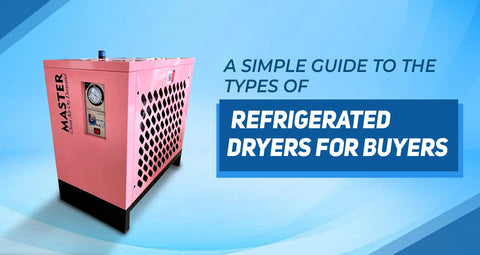Demystifying Refrigerated Air Dryers: Finding the Ideal Dryer for Your Compressed Air System
What Are Refrigerated Air Dryers?
Refrigerated air dryers work by cooling the compressed air to a temperature where moisture condenses into liquid water, which is then separated and drained from the system. This cooling process typically brings the air temperature down to about 3°C (37°F), achieving a pressure dew point sufficient for many industrial applications. By eliminating moisture, these dryers prevent rust, bacterial growth, and potential freeze-ups in the air supply lines.
Exploring the Main Types of Refrigerated Air Dryers
Refrigerated dryers come primarily in three varieties, each with its operational traits and energy profiles:
Non-Cycling Refrigerated Dryers
These operate continuously at full capacity irrespective of air demand, providing steady cooling and a constant dew point. They tend to have a lower initial cost, making them ideal for facilities with stable, high air flow rates. However, they consume full energy even during low usage periods.Cycling Refrigerated Dryers
Cycling dryers regulate their refrigeration compressor based on actual air demand. They often use a thermal mass or digital scroll compressor technology to cycle on and off or modulate compression capacity. This cycling reduces energy consumption significantly compared to non-cycling dryers, proving advantageous for systems with fluctuating air usage.Variable Speed Drive (VSD) Refrigerated Dryers
VSD dryers represent the most energy-efficient class, adjusting compressor speed dynamically to match air flow precisely. This real-time modulation lowers power consumption markedly and maintains a stable dew point, making them a smart long-term choice for facilities prioritizing energy savings and environmental impact.
Key Considerations for Selecting the Right Air Dryer
Choosing an appropriate refrigerated air dryer depends on various factors tailored to your system and application:
Air Flow and Capacity
Evaluate the maximum compressed air volume your system delivers at operating pressure. Select a dryer rated slightly above this capacity (typically 10-20% higher) to handle peak demands without overloading.Operating Pressure
Dryer performance varies with air pressure. Higher pressures reduce drying capacity, so confirm compatibility with your system's pressure ratings.Required Dew Point
Refrigerated dryers commonly achieve dew points around 3°C. For applications requiring drier air or freeze protection, consider alternative drying technologies like desiccant dryers.Energy Efficiency and Costs
While non-cycling dryers have lower upfront costs, cycling and especially VSD dryers deliver significant energy savings and lower operating expenses over time.Maintenance and Reliability
Assess maintenance demands—simpler designs can mean easier upkeep, but advanced models with smart controls may provide longer service intervals and better protection.Environmental Conditions
Ambient temperature and inlet air temperature affect dryer sizing and effectiveness. Hotter environments or elevated inlet air temperatures may necessitate more robust or larger units.
Conclusion
Refrigerated air dryers are an essential investment for protecting compressed air systems against moisture-related issues. By understanding the distinctions between non-cycling, cycling, and VSD models and considering your specific operational needs—from air flow to energy efficiency—you can select a dryer that offers reliable performance, cost savings, and peace of mind. With the right refrigerated air dryer, your compressed air will remain dry, clean, and ready to support your operations optimally.
This version covers the fundamental concepts of refrigerated air dryers, details the types and their operating principles, and highlights critical decision points for selecting the best dryer without copying the original source, ensuring uniqueness and up-to-date relevance.


Comments
Post a Comment